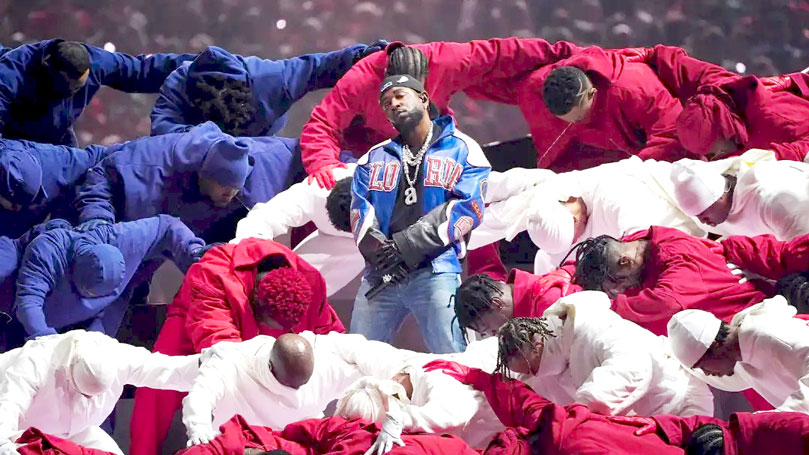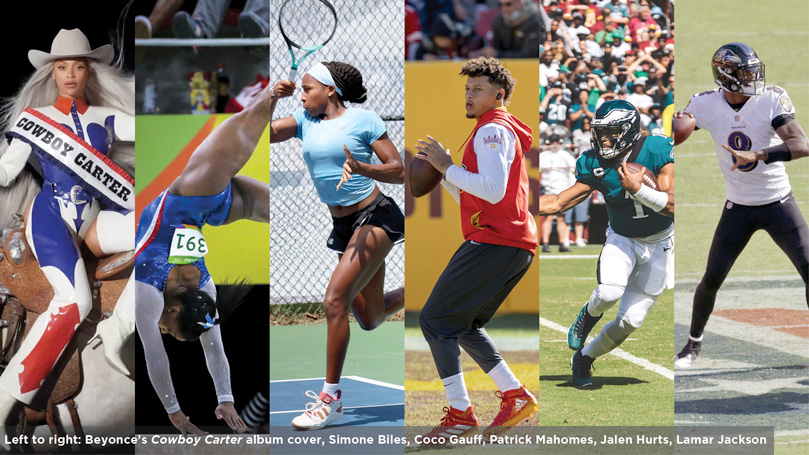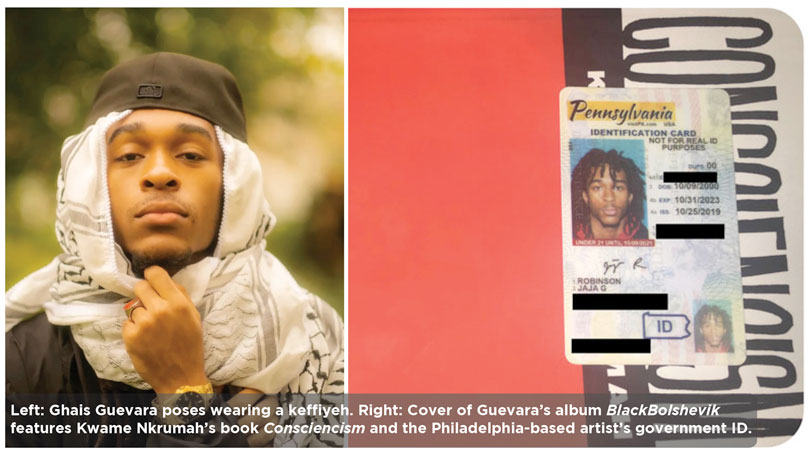
On February 9th 2025, nearly 134 million viewers tuned in to watch Kendrick Duckworth, known by his stage name “Kendrick Lamar,” perform at halftime during Super Bowl LIX, making it the most watched halftime performance in history. The ease with which the Pulitzer Prize winning rapper was able to attract such tremendous attention has much to do with his 2024 public spat with rap colleague Aubrey “Drake” Graham, along with his career musical accolades.
However, when contextualized with the current political reality facing Black Americans and the working class generally, a better understanding of his popularity is brought to light. When teased apart, it provides valuable insights into socio-political narratives within Black American culture and the broader cultural resistance against far right political advances; this resistance being against attempts to grow fascist cultural influence within the Black community while simultaneously attacking existing Black culture that serves to promote anti-racist, progressive, and working class messages.
This past year is not the first time where the lyrical messaging in Duckworth’s music has coincided with the political atmosphere at the time. His third studio album, To Pimp A Butterfly, released in the first quarter of 2015, is one of the most notable examples of this. In the years preceding its release, the country witnessed both the re-election of President Barack Obama, our first and only Black President, as well as the racially motivated murders of Trayvon Martin, Michael Brown, Eric Garner, and others. The album’s cover art depicts a group of mostly Black men joyously standing over what is seemingly the body of a white judge on the White House lawn. This artwork perfectly encapsulates the messaging contained within nearly every song of the album.
To Pimp A Butterfly and its cover art can be viewed as a hyperbolic, yet candid depiction of the complicated relationship and feelings between the Black community and the U.S. nation at the time of its release. In the song, “The Blacker The Berry,” Duckworth directly addresses the white supremacist character of racial capitalism with, “You hate me, don’t you? You have my people, your plan is to terminate my culture” and “You sabotage my community, making a killing.” Other songs on the album more so highlight the culture of resistance that exists in the Black community. Notably, the upbeat track, “Alright,” with its famous line “we gon’ be alright,” was popular and frequently played in spaces organizing against police violence. In many ways, this album is and continues to be a defining feature of the Black Lives Matter movement.
The context of 2024
Similarly, the diss tracks that resulted from his rap beef with Drake in 2024 were atmospheric in that it contained a political message that was informed by socio-political narratives in the Black community at the time and defined the political tone for the whole of the working class in the months preceding their release. On the surface, Kendrick Lamar’s ire was indeed aimed specifically at Drake. Much of the criticism had to do with Drake’s exploitation of Black American culture as an outsider (Drake is Black, but a Canadian native). However, the points directed at Drake can be extrapolated out to the larger case of fascist encroachment on Black culture and resistance to it within the Black community.
Fascist ideologues attempt to grow their influence over notable figures in the Black community while attacking any aspect of Black culture that lends itself to resistance.
This strategic encroachment, aimed at garnering more support within the Black voter bloc, is two-pronged. On one side, fascist ideologues take advantage of, or attempt to grow their influence over, notable figures in the Black community. The most glaring example of this is the association between far right actors and rapper Kanye West, who has suffered mental health woes since the passing of his mother. It cannot be viewed as coincidental that far right actors continue to push him into the media limelight as his condition apparently deteriorates. In addition, there have also been a number of Black podcasters or non-Black commentators who discuss Black culture, spewing far-right, bigoted ideas such as the Fresh & Fit podcast and streamer Adin Ross.
On the other side, far right commentators have taken to dismissing or outright attacking any aspect of Black culture that lends itself to resistance against oppression.

Although Black superstar Beyonce’s Cowboy Carter won album of the year at the 2025 Grammy Awards, the album itself faced criticism. It was dismissed by the 2024 Country Music Awards, receiving not a single nomination. Country music artist John Rich, known more for his extreme right wing beliefs and less for his music, called the album a “total joke.” Her race and gender cannot be discounted as reasons for the backlash. Additionally, lines from the album such as, “My family live and died in America, Good ol’ USA … Whole lotta red in that white and blue, History can’t be erased,” which explicitly acknowledge and criticize our country’s history of oppression against Black Americans, add another layer to attacks against the album. Modern country music tends to uncritically lionize our country and its history. Meaning for some, Beyonce’s critical, but accurate account of the United State’s from her perspective as a Black woman flies in the face of common narratives in country music.
Far right political actors continue to try to erase these narratives surrounding historical oppression of Black Americans through banning books on the topic, gutting African American studies courses, and more. Therefore, their ire against Beyonce for popularly promoting accurate, yet seldomly voiced accounts of American history through her music is unsurprising.
These attacks are not limited to the musical realm. They extend to Black athletes, even those who represent our country on the highest stage.
During the 2020 Summer Olympic Games, Black gymnast Simone Biles received a barrage of hate from the far right, with Charlie Kirk acting as the ring leader, after she made the decision to withdraw from the final competition to protect her mental health. Despite being labeled “lazy” and “weak,” she went on to win multiple gold medals during the 2024 Summer Olympics.
Similarly, Black tennis player Coco Gauff faced criticism after she was chosen to be the United State’s flag bearer alongside Black basketball player LeBron James, for the 2024 Olympic Games. This criticism had little to do with her athletic skills, and more to do with her identity. As one right wing commentator put it, “Coco Gauff=Kamala Harris.” To them, she was only chosen to be the flag bearer because she is Black and a woman in the same way right winger’s tend to believe Harris was only nominated by the Democratic Party as the 2024 Presidential nominee because she is also Black and a woman.
It’s important to note that currently, Gauff is the 3rd highest ranked woman tennis player in singles internationally, with no other American woman ranked higher. Additionally, policies aside, Harris has two decades of political experience and even more years of experience as a lawyer.
The narratives surrounding Black quarterbacks (QBs) in the NFL is of course relevant to this conversation as well. This year’s Super Bowl between the Philadelphia Eagles and Kansas City Chiefs (Super Bowl 59) was a rematch of Super Bowl 57, which was the first time the two starting QBs were both Black. Despite them both reaching the NFL championship game twice in that two-year time period, they received very different appraisals from sports media and fans. Chiefs QB Patrick Mahomes is widely regarded as the best in the game currently and maybe even of all time. This title is warranted, given his ability to carry the team in desperate moments and bring the team to five Super Bowl Championship games and winning three. Before his win and game MVP level performance at Super Bowl 59, Jalen Hurts, on the other hand, was hardly ever regarded as an “elite” QB. Strangely, white QBs such as Josh Allen and Joe Burrow are consistently ranked over Hurts by sports media talking heads. Neither Allen nor Burrow have beaten Mahomes in a playoff game, whereas Jalen Hurts has. Black QB of the Baltimore Raven, Lamar Jackson, faced similar criticisms on his ability to play the position until his multiple MVP caliber seasons made it undeniable that his talent rivals that of Mahomes. Both Jackson and Hurts continue to play at a high level despite criticisms clearly rooted in their race.
The halftime show
The content of Kendrick Lamar’s Super Bowl Halftime Show performance brought the issue of right wing attacks on the culture of resistance in the Black community to the fore. From the very beginning, before the performance even began, this political message was introduced. The introductory song that played as the camera panned over the Superdome was “The Old Guard Is Dead” from Philadelphia-based rapper, Ghais Guevara. The title of the song is noteworthy, as was the choice of including the Philly native whose music is heavily inspired by the Black liberation movement, as well as the movement for socialism.

The performance itself was titled “The Great American Game,” narrated by Samuel L. Jackson as “Uncle Sam,” and utilized dancers dressed in red, white, and blue, representing the U.S. flag. Duckworth used songs, new and old, from his discography to synthesize the stories of Beyonce, Coco Gauff, Jalen Hurts, and Lamar Jackson with the broader history of resistance to racial oppression by Black Americans. “Too loud, too reckless, too ghetto” said “Uncle” Samuel L. Jackson to the performance of the song “Squabble Up” — a criticism often levied at Black cultural expressions by the right. In response, Duckworth performed the song “HUMBLE,” highlighting another expression Black folks often hear with the lyrics, “Sit down, be humble.”
Towards the end of the performance, the Grammy Award winning song “Not Like Us” was performed, despite lawsuits and threat of lawsuit from Drake, the subject of the diss track.
Kendrick Lamar’s song choices represent a rejection of the “Great American Game” and white supremacist culture perpetuated by capitalism.
He was joined by Serena Williams, another Black woman athlete who has faced unwarranted criticism on account of her race and gender. It’s important to note that Drake, who was once romantically linked to Williams, has a propensity to disparage his ex-girlfriends in his music. Her appearance seems to be a doubling-down of the “Not Like Us” lyric, “better not ever speak on Serena,” where Kendrick demands that she be treated with the respect that is afforded to her within the Black community because of her contributions. What’s clear is that Kendrick Lamar’s performance setlist was intentionally chosen. His song choices represent a rejection of the “Great American Game” and white supremacist culture perpetuated by capitalism.
Music, culture, Black and working class resistance
Historically, our Party has teased out the political implications from cultural events as a way to not only grow membership but also advance the working class struggle. One notable example was the struggle to integrate baseball pushed by Lester Rodney, the sports columnist for the Daily Worker.
The same must be true today, especially as MAGA attempts to encroach on and influence culture across racial and ethnic lines. It is true that popular culture and cultural phenomena are oftentimes products of capitalism, and Communists should be mindful of this fact. However, it is also true that working class culture exists and is intertwined with said phenomena, although not always immediately salient. Blanket rejections of U.S. culture keep us at an arm’s length from working people, who are indeed invested in the cultural happenings of our country. Instead, we should work to leave a working class stamp on popular narratives stemming from culture, just as we fight to leave a working class stamp on narratives stemming from politics. We should also do the necessary work of teasing out the progressive and working class elements of capitalist cultural products, especially when those products are popular within oppressed groups.
The struggle to influence and comment on culture or the “culture wars,” as the far right calls it, is not something Communists should take lightly or ignore. It requires as much of our attention as the political or economic struggle does, as the three — culture, politics and economics — are not so distinctive. We see that Trump’s assault on DEI within the federal government and the anti-racist hegemonic gains forged in the struggle against racist oppression have, to date, cost hundreds to thousands of Black workers, women workers, queer workers, and others their jobs and will likely cost thousands more. Private sector rollbacks of DEI policies, along with these new government policies, leave many minorities without protections against discrimination in the workplace.
Art as resistance
Resistance through art is a deeply rooted tradition in our country, particularly in the Black community. Historically, music has been one of the most reliable vehicles for the popularization of pro-resistance narratives and the political reality facing Black workers. From slave hymns to conscious rap, from “Strange Fruit” by Billie Holiday to “Almeda” by Solange Knowls, music continues to serve as a valuable form of expression in the struggle against racist oppression under capitalism. The year 2024 was no different and this cannot be overstated. Kendrick Lamar and Beyonce winning multiple Grammy awards for their musical releases and subsequently performing halftime shows at two primetime NFL games (the Super Bowl and Christmas Day game, respectively) signify that their message resonated with and was popular amongst the masses of U.S. people. Despite what Trump and Musk say about the unpopularity of equality and diversity, it is clear that both of those ideals are still accepted and sought after by workers. Thus, the coming years under Trump will be no different. Music and other forms of art will continue to be valuable tools in the struggle against fascism and the far right.
The opinions of the author do not necessarily reflect the positions of the CPUSA.
Images: Kendrick Lamar during Super Bowl LIX (AFP via freemalaysiatoday.com); Beyonce’s Cowboy Carter album cover (Pitchfork), Simone Biles by Danilo Borges/brasil2016.gov.br (CC BY-SA 3.0), Coco Gauff (Wikimedia), Patrick Mahomes by All-Pro Reels (CC BY-SA 2.0), Jalen Hurts (Ibid.), Lamar Jackson (Ibid.); Ghais Guevara poses in a keffiyeh (VICE)/ BlackBolshevik album cover by Ghais Guevara (Bandcamp)


 Join Now
Join Now